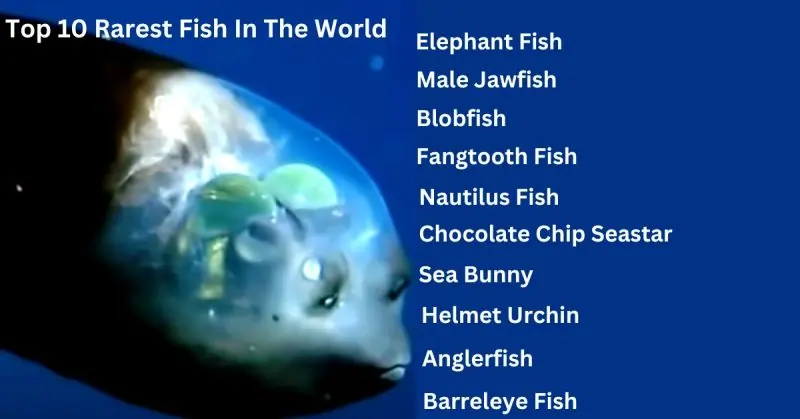Dive into the unseen world beneath the waves with our exciting look at the “Top 10 Rarest Fish In The World.” These unique marine dwellers have adapted to some of the most extreme conditions on Earth, thriving in depths and environments that are often beyond human reach. From the eerie depths where sunlight fades to the vibrant coral reefs, each fish presents a story of survival and adaptation. Join us as we explore these rare beauties of the deep, marveling at their extraordinary forms, colors, and life histories. This guide promises to enlighten and amaze you with the hidden wonders of our oceans.
Top 10 Rarest Fish In The World
1. Elephant Fish (Gnathonemus petersii)
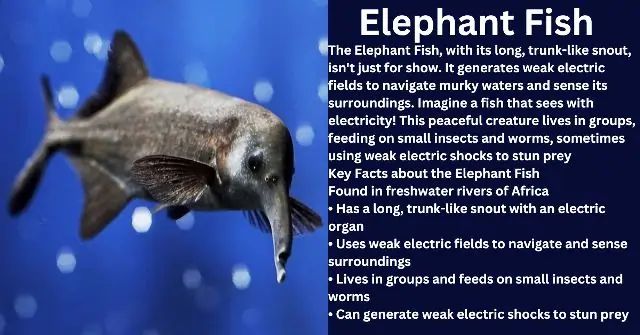
Equipped with a long, trunk-like snout, the African freshwater river elephant fish is a distinctive species. This peculiar characteristic produces weak electrical fields and is not merely for display. It is an electric organ. The Elephant Fish uses these electrical pulses to navigate murky waters and sense its surroundings.
Imagine a fish that can see with electricity! These weak pulses bounce off objects, allowing the Elephant Fish to form a mental picture of its environment. This electrical sense is especially helpful at night or in murky water where visibility is low.
Elephant Fish are peaceful creatures that live in groups. They primarily feed on small insects and worms that they find using their electric sense. They can even use weak electric shocks to stun their prey before consuming them.
Here are some key facts to remember about the Elephant Fish:
- Found in freshwater rivers of Africa
- Has a long, trunk-like snout with an electric organ
- Uses weak electric fields to navigate and sense surroundings
- Lives in groups and feeds on small insects and worms
- Can generate weak electric shocks to stun prey
2. Male Jawfish (Opistognathus aurifrons)
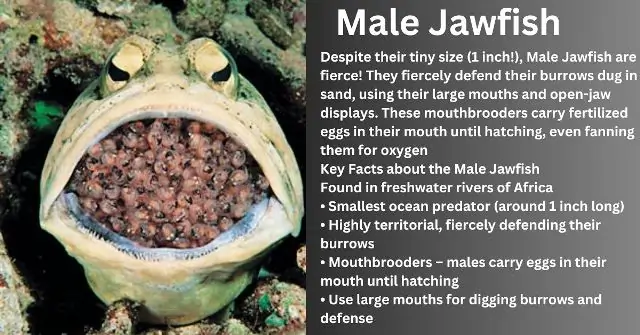
Image Source:https://www.pinterest.ph/Lurheilija/
Don’t be fooled by their size! The small nightmares of the reef are male jawfish, also called yellowheaded jawfish (Opistognathus aurifrons). The tiniest predators in the water, these fish are barely an inch (2.5 cm) long.
Despite their size, they are fiercely territorial. Male Jawfish live in burrows they dig in the sand or rubble, using their large mouths to scoop out the material. They are very protective of their homes, and will readily defend them against intruders, even much larger fish. Their defense tactics include displaying their open jaws and even spitting sand!
Male Jawfish have another interesting adaptation – they are mouthbrooders! The male carries the fertilized eggs in his mouth until they hatch after mating. He gives them careful attention, even using his fins to fan them so they get enough oxygen.
Here are some key facts to remember about the Male Jawfish:
- Smallest ocean predator (around 1 inch long)
- Highly territorial, fiercely defending their burrows
- Mouthbrooders – males carry eggs in their mouth until hatching
- Use large mouths for digging burrows and defense
3. Blobfish (Psychrolutes marcidus)
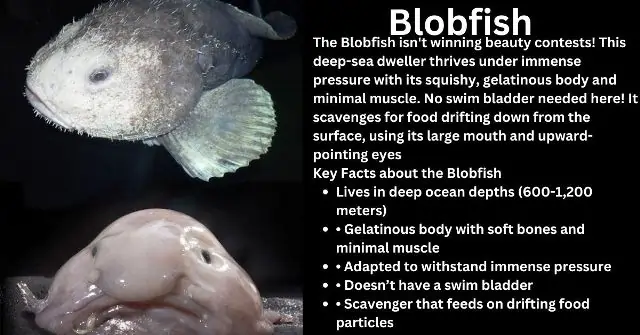
Image source: https://www.pinterest.ph/ashlartistry/
Psychrolutes marcidus, as the scientific name for this interesting organism, isn’t particularly attractive, but it’s well suited to its hostile surroundings. The Blobfish does not require a swim bladder in order to survive at the abysmal depths of the ocean, which range from 600 to 1,200 meters (2,000 to 3,900 ft). On the contrary, its body is a gelatinous mass of limited muscle and extremely soft bones. It can sustain the extreme pressure of the deep sea without using up energy thanks to its mushy construction.
Despite its appearance, the Blobfish isn’t a bottom feeder. Its large mouth and upward-pointing eyes help it scavenge for food drifting down from the surface. They even have small barbs around their mouths to help them hold onto their prey.
Here are some key facts to remember about the Blobfish:
- Lives in deep ocean depths (600-1,200 meters)
- Gelatinous body with soft bones and minimal muscle
- Adapted to withstand immense pressure
- Doesn’t have a swim bladder
- Scavenger that feeds on drifting food particles
4. Fangtooth Fish (Anoplogaster cornuta)

Image source: https://www.pinterest.ph/dailymail/
The Fangtooth Fish (Anoplogaster cornuta), despite its humorous name, is a dangerous predator that may be found at depths of up to 2 kilometers (almost a mile) in the gloomy shadows of the ocean. This fish lives up to its name—it possesses the largest teeth about its body size of any fish in the sea! Envision needle-like fangs that can retract when not in use, only to emerge and seize a morsel of food!
Imagine needle-like fangs that curve inwards and can fold flat against its lower jaw. When the Fangtooth Fish opens its mouth wide, these enormous teeth erupt, ready to snag unsuspecting prey. They even have special sockets in their upper jaw to accommodate these impressive chompers when their mouth is closed!
Living in the darkness, good eyesight isn’t crucial. The Fangtooth Fish, on the other hand, uses its enormous, light-sensitive eyes to sense movement in the water and bioluminescence, or illuminating organisms. It can swiftly and effectively seize prey because to its strong jaws and pointed teeth.
Here are some key facts to remember about the Fangtooth Fish:
- Found in the deep ocean (500-2,000 meters)
- Holds the record for most teeth relative to body size
- Has massive, needle-like fangs that fold into its jaw
- Relies on bioluminescence and movement for prey detection
- Powerful jaws and sharp teeth for swift predation
5. Nautilus Fish (Nautilus pompilius)

The Nautilus (Nautilus pompilius) might not be a true fish, but it’s still an amazing creature that belongs on our list! Nicknamed a “living fossil,” the Nautilus is more like a cousin to octopuses and squids. It’s a type of mollusk, which means it has a shell – a beautiful, spiraled one in this case! However, the nautilus bears its home—a gorgeous spiral shell—on its back, unlike its cousins.
Fossils reveal that these incredible creatures had existed for millions of years, predating even the dinosaurs! Their jet-propelled bodies allow them to move slowly over the seafloor where they inhabit deep ocean waters. Their numerous tentacles enable them to scavenge food, such as shrimp and dead fish.
The shell of the Nautilus is interesting. The animal resides in the main chamber, which is separated into sections. It creates bigger, new chambers as it expands, closing off the previous ones. Because of this, they can stay afloat and withstand the extreme pressure found in the deep water.
Here are some key facts to remember about the Nautilus:
- Not technically a fish, but a cephalopod related to octopuses and squids
- Nicknamed a “living fossil” due to its long evolutionary history
- Lives in deep ocean waters and has a beautiful, spiraled shell
- Uses tentacles to scavenge for food
- Shell is divided into chambers, helping it manage buoyancy and pressure
Beyond Fish: Rare Ocean Wonders
The ocean’s depths aren’t just home to rare fish. Here are some fascinating non-fish creatures that deserve a spot on our list:
6. Chocolate Chip Seastar (Astrocassides octonarius)

Image source:https://www.michaelandersongallery.com/
Though it may have a cute moniker, the Chocolate Chip Seastar (Astrocassides octonarius) is not something you should eat! The bioluminescent spots covering this starfish’s body, which resemble little chocolate chips, give rise to its endearing moniker. The seastar uses these microscopic lights for more than simply ornamentation; they facilitate communication and lure potential prey.
The Chocolate Chip Seastar is a species that lives in the deep water and prefers regions with little to no sunshine. It is able to locate food, navigate, and even fend off predators thanks to its bioluminescence. These amazing starfish are also filter feeders; they use their microscopic hairs to collect food particles that are carried by the current in the water.
With its many tube feet, the Chocolate Chip Seastar can gently crawl down the seafloor, though not nearly as quickly as a cheetah. It can move, adhere to surfaces, and even sense its environment thanks to these microscopic, tube-like structures.
Here are some key facts to remember about the Chocolate Chip Seastar:
- Found in the deep ocean
- Covered in bioluminescent dots that resemble chocolate chips
- Uses bioluminescence for communication, attracting prey, and defense
- Filter feeder that catches small food particles in the water
- Moves using tiny tube feet on its underside
7. Sea Bunny (Jorunna parva)
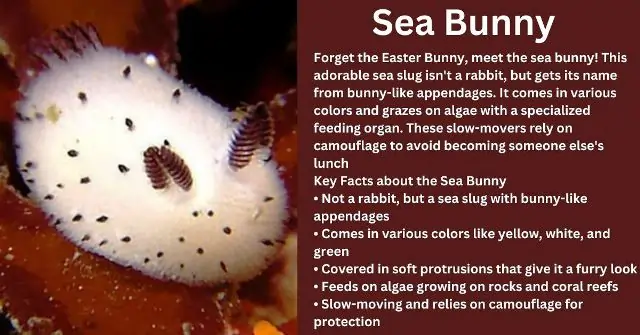
Image source: https://i.pinimg.com/originals
The sea bunny (Jorunna parva) is a new animal to replace the Easter Bunny! This sea slug is amazing; it lives in the ocean, not like a bunny hopping across meadows. Though they aren’t true bunnies, these cute animals bear the nickname because of their finger-like appendages that mimic bunny ears.
There are many different hues of sea bunnies, like as yellow, white, and occasionally even green. Their bodies are coated in papillae, which are soft projections that give them a hairy look. These papillae might aid in their ability to perceive their environment and take in water-borne nutrients.
Sea bunnies eat plants, as opposed to their land-dwelling counterparts. A radula is a specialized feeding organ that they use to graze on algae that grows on rocks and coral reefs. Being sluggish creatures, they hide from predators through camouflage.
Here are some key facts to remember about the Sea Bunny:
- Not a rabbit, but a sea slug with bunny-like appendages
- Comes in various colors like yellow, white, and green
- Covered in soft protrusions that give it a furry look
- Feeds on algae growing on rocks and coral reefs
- Slow-moving and relies on camouflage for protection
8. Helmet Urchin (Trepangia suite)
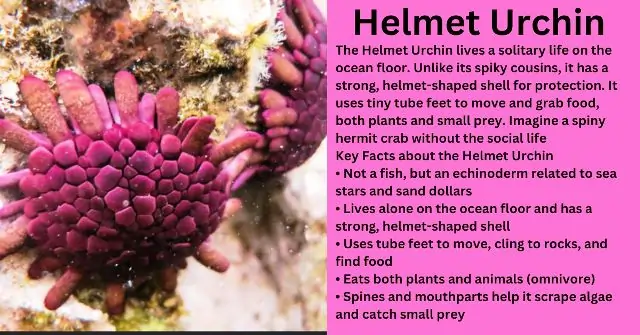
The Helmet Urchin (Trepangia suite) isn’t a fish, but it’s a cool creature that deserves a spot on our list. Living a solitary life on the ocean floor, this spiny oddity gets its name from its unique shell. Unlike the round sea urchins you might picture, the Helmet Urchin has a strong, helmet-shaped shell that covers its body. This hard hat protects it from strong currents and hungry predators.
While not exactly speedy, the Helmet Urchin can slowly move around using its tube feet. These tiny, suction-cupped feet help it crawl, cling to rocks, and even scoop up food. Speaking of food, the Helmet Urchin is an omnivore, meaning it eats both plants and animals. It uses its tiny spines and specialized mouthparts to scrape algae off rocks or snatch small prey drifting by.
Here are some key facts to remember about the Helmet Urchin:
- Not a fish, but an echinoderm related to sea stars and sand dollars
- Lives alone on the ocean floor and has a strong, helmet-shaped shell
- Uses tube feet to move, cling to rocks, and find food
- Eats both plants and animals (omnivore)
- Spines and mouthparts help it scrape algae and catch small prey
9. Anglerfish (Lophiiformes)

Image source: https://www.artstation.com/
Not just any fish, but the Anglerfish (Lophiiformes) is unique. With a special adaption, this expert predator of the deep water, which inhabits depths of 1,000 to 3,000 meters, can entice unwary prey. Picture a fish with an appendage of flesh above its head that functions similarly to a fishing pole!
This “fishing rod” actually has a bioluminescent lure at the tip. The Anglerfish can dangle this glowing light to attract curious creatures closer. Once the prey is within reach, the Anglerfish’s enormous mouth with sharp teeth snaps shut, leaving the unfortunate victim with no chance of escape.
These anglerfish come in a variety of strange shapes and sizes, with some even having expandable bodies to swallow prey much larger than themselves. They don’t rely on eyesight much in the darkness, so some anglerfish even have special lures that emit smells to further entice their prey.
Here are some key facts to remember about the Anglerfish:
- Found in the deep ocean (1,000-3,000 meters)
- Uses a bioluminescent lure on a “fishing rod” to attract prey
- Has a large mouth with sharp teeth to capture prey
- Comes in various shapes and sizes, some with expandable bodies
- May use smelly lures to attract prey in the darkness
10. Barreleye Fish (Macropinna microstoma)

Image source: https://www.facebook.com/
The title of strangest-looking fish in the ocean may go to the Barreleye Fish (Macropinna microstoma). This translucent head belongs to a genuinely unique trait of this deep-sea (600–800 m) resident: its eyes!
Imagine a fish with two tiny green orbs seemingly lodged in its forehead. These aren’t its eyes, though! The Barreleye Fish has two small, functional nostrils where you’d expect eyes. Its real eyes, however, are barrel-shaped and pointed upwards, encased in a clear, fluid-filled dome within its head. This allows them to see faint bioluminescent light filtering down from the surface, helping them navigate the darkness.
The tiny green orbs in the forehead act like magnifying glasses, collecting even more light for the upward-facing eyes. This incredible adaptation allows the Barreleye Fish to see both above and in front of itself, giving it an advantage in the dark depths of the ocean.
Here are some key facts to remember about the Barreleye Fish:
- Found in the deep ocean (600-800 meters)
- Has a transparent head with upward-facing eyes encased in a dome
- Tiny green “eyes” are actually nostrils
- Upward-facing eyes see bioluminescent light for navigation
- Barrel-shaped eyes with green “magnifying glasses” for extra light
FAQ on ” Top 10 Rarest Fish In The World”
Q-Can you eat these rare fish?
A- No, most are difficult to catch or live in extreme environments
Q- Can I keep them as pets?
A- Few can be kept in specialized aquariums
Q- Why are they so rare?
A- Deep habitat, specific food, or limited populations
Q- How can I learn more about them?
A- Research deep-sea creatures or specific fish breeds
.
Blog Post Conclusion–Top 10 Rarest Fish In The World
So there you have it! Our deep dive into the top 10 rarest fish (and a few bonus non-fish friends) that call the ocean depths home. These extraordinary organisms, which range from electric navigators to toothy terrors to light-show stars, demonstrate the remarkable diversity and adaptability that can be found in our waters.
Who knows what other odd and fascinating species might be lurking in the deep water, which is still largely uncharted territory? We appreciate your participation in our underwater exploration! Let us know in the comments below – which rare creature surprised you the most. Do you have any favorite deep-sea wonders you’d like to share?
You may love to read our amazing post on : Top 10 Most Expensive Fish In The World: : Ultimate Guide
‘
